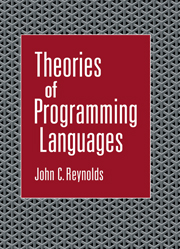Book contents
- Frontmatter
- Contents
- Preface
- 1 Predicate Logic
- 2 The Simple Imperative Language
- 3 Program Specifications and Their Proofs
- 4 Arrays
- 5 Failure, Input-Output, and Continuations
- 6 Transition Semantics
- 7 Nondeterminism and Guarded Commands
- 8 Shared-Variable Concurrency
- 9 Communicating Sequential Processes
- 10 The Lambda Calculus
- 11 An Eager Functional Language
- 12 Continuations in a Functional Language
- 13 Iswim-like Languages
- 14 A Normal-Order Language
- 15 The Simple Type System
- 16 Subtypes and Intersection Types
- 17 Polymorphism
- 18 Module Specification
- 19 Algol-like Languages
- Appendix: Mathematical Background
- Bibliography
- Index
7 - Nondeterminism and Guarded Commands
Published online by Cambridge University Press: 28 January 2010
- Frontmatter
- Contents
- Preface
- 1 Predicate Logic
- 2 The Simple Imperative Language
- 3 Program Specifications and Their Proofs
- 4 Arrays
- 5 Failure, Input-Output, and Continuations
- 6 Transition Semantics
- 7 Nondeterminism and Guarded Commands
- 8 Shared-Variable Concurrency
- 9 Communicating Sequential Processes
- 10 The Lambda Calculus
- 11 An Eager Functional Language
- 12 Continuations in a Functional Language
- 13 Iswim-like Languages
- 14 A Normal-Order Language
- 15 The Simple Type System
- 16 Subtypes and Intersection Types
- 17 Polymorphism
- 18 Module Specification
- 19 Algol-like Languages
- Appendix: Mathematical Background
- Bibliography
- Index
Summary
A nondeterministic program is one that does not completely determine the behavior of a computer, so that different executions of the same program with the same initial state and input can give different results. Although concurrent programs are usually nondeterministic, the topics of nondeterminism and concurrency are distinct, and it is pedagogically sensible to consider nondeterminism by itself before plunging on to concurrency.
Moreover, even with purely sequential computation, nondeterministic programs are often desirable because they avoid unnecessary commitments. Such commitments can make programs harder to read and to reason about. Even more seriously, in programs that use abstract types, they can place unnecessary constraints on the choice of data representations.
(Just as one can have nondeterministic sequential programs, one can also have deterministic concurrent ones — often called parallel programs — as will be evident when we consider functional programming languages.)
In this chapter we will explore Dijkstra's guarded commands, which are the most widely accepted and studied mechanism for extending the simple imperative language to nondeterministic programming.
In contrast to the previous chapters, we will begin with operational semantics, extending the development of the previous chapter. Then, after introducing powerdomains, we will give a direct denotational semantics for our nondeterministic language (excluding intermediate input and output). Finally, we will extend the specification methods of Chapter 3 to nondeterminism (again excluding input and output) and also deal briefly with weakest preconditions.
Before proceeding further, however, we must clear up a potential confusion. In automata theory, the result of a nondeterministic automaton is defined to be the the union of the results of all possible executions.
Information
- Type
- Chapter
- Information
- Theories of Programming Languages , pp. 136 - 154Publisher: Cambridge University PressPrint publication year: 1998
